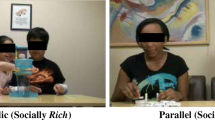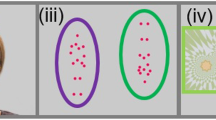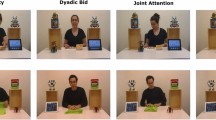Abstract
This study used eye-tracking to examine visual attention to faces and objects in adolescents with autism spectrum disorder (ASD) and typical peers. Point of gaze was recorded during passive viewing of images of human faces, inverted human faces, monkey faces, three-dimensional curvilinear objects, and two-dimensional geometric patterns. Individuals with ASD obtained lower scores on measures of face recognition and social-emotional functioning but exhibited similar patterns of visual attention. In individuals with ASD, face recognition performance was associated with social adaptive function. Results highlight heterogeneity in manifestation of social deficits in ASD and suggest that naturalistic assessments are important for quantifying atypicalities in visual attention.


Similar content being viewed by others
References
American Psychiatric Association. (2000). Diagnostic and statistical manual of mental disorders: DSM-IV-TR (4th ed.). Washington, DC: American Psychiatric Association.
Anderson, C., Colombo, J., & Shaddy, D. (2006). Visual scanning and pupillary responses in young children with autism spectrum disorder. Journal of Clinical and Experimental Neuropsychology, 28, 1238–1256.
Baron-Cohen, S., Wheelwright, S., Scahill, V., Lawson, J., & Spong, A. (2001). Are intuitive physics and intuitive psychology independent? A test with children with Asperger Syndrome. Journal of Developmental and Learning Disorders, 5, 47–78.
Behrmann, M., Thomas, C., & Humphreys, K. (2006). Seeing it differently: Visual processing in autism. Trends in Cognitive Sciences, 10(6), 258–264.
Boucher, J., & Lewis, V. (1992). Unfamiliar face recognition in relatively able autistic children. Journal of Child Psychology and Psychaitry, 33, 843–859.
Boucher, J., Lewis, V., & Collis, G. (1998). Familiar face and voice matching and recognition in children with autism. Journal of Child Psychology and Psychiatry, 39, 171–181.
Cheung, C., Mayes, L., Rutherford, H., & McPartland, J. (2010). Social personality traits predict early brain responses to human faces. Social Neuroscience (in press).
Cohen, M. J. (1997). Children’s memory scale. San Antonio, TX: The Psychological Corporation.
Constantino, J. (2003). Social responsiveness scale. Los Angeles, CA: Western Psychological Services.
Corden, B., Chilvers, R., & Skuse, D. (2008). Avoidance of emotionally arousing stimuli predicts social-perceptual impairment in Asperger’s syndrome. Neuropsychologia, 46(1), 137–147.
Dapretto, M., Davies, M. S., Pfeifer, J. H., Scott, A. A., Sigman, M., Bookheimer, S. Y., et al. (2006). Understanding emotions in others: mirror neuron dysfunction in children with autism spectrum disorders. Nature Neuroscience, 9(1), 28–30.
Dawson, G., Carver, L., Meltzoff, A. N., Panagiotides, H., McPartland, J., & Webb, S. J. (2002). Neural correlates of face and object recognition in young children with autism spectrum disorder, developmental delay, and typical development. Child Development, 73(3), 700–717.
Dawson, G., Webb, S. J., & McPartland, J. (2005). Understanding the nature of face processing impairment in autism: Insights from behavioral and electrophysiological studies. Developmental Neuropsychology, 27(3), 403–424.
Elgar, K., & Campbell, R. (2001). Annotation: The cognitive neuroscience of face recognition: Implications for developmental disorders. Journal of Child Psychology and Psychiatry and Allied Disciplines, 42(6), 705–717.
Falck-Ytter, T. (2008). Face inversion effects in autism: A combined looking time and pupillometric study. Autism Research, 1(5), 297–306.
Farroni, T., Csibra, G., Simion, F., & Johnson, M. H. (2002). Eye contact detection in humans from birth. Proceedings of the National Academy of Sciences of the United States of America, 99(14), 9602–9605.
Farroni, T., Johnson, M. H., Menon, E., Zulian, L., Faraguna, D., & Csibra, G. (2005). Newborns’ preference for face-relevant stimuli: Effects of contrast polarity. Proceedings of the National Academy of Sciences of the United States of America, 102(47), 17245–17250.
Fray, P. J., Robbins, T. W., & Sahakian, B. J. (1996). Neuropsychiatric applications of CANTAB. International Journal of Geriatric Psychiatry, 11, 329–336.
Freire, A., Lee, K., & Symons, L. A. (2000). The face-inversion effect as a deficit in the encoding of configural information: Direct evidence. Perception, 29(2), 159–170.
Gauthier, I., & Tarr, M. J. (1997). Becoming a “Greeble” expert: Exploring mechanisms for face recognition. Vision Research, 37(12), 1673–1682.
Goldberg, M. C., Lasker, A. G., Zee, D. S., Garth, E., Tien, A., & Landa, R. J. (2002). Deficits in the initiation of eye movements in the absence of a visual target in adolescents with high functioning autism. Neuropsychologia., 40(12), 2039–2049.
Hadjikhani, N., Joseph, R. M., Snyder, J., Chabris, C. F., Clark, J., Steele, S., et al. (2004). Activation of the fusiform gyrus when individuals with autism spectrum disorder view faces. Neuroimage, 22(3), 1141–1150.
Hadjikhani, N., Joseph, R. M., Snyder, J., & Tager-Flusberg, H. (2007). Abnormal activation of the social brain during face perception in autism. Human Brain Mapping, 28(5), 441–449.
Haith, M. M., Bergman, T., & Moore, M. J. (1977). Eye contact and face scanning in early infancy. Science, 198(4319), 853–855.
Hernandez, N., Metzger, A., Magné, R., Bonnet-Brilhault, F., Roux, S., Barthelemy, C., et al. (2009). Exploration of core features of a human face by healthy and autistic adults analyzed by visual scanning. Neuropsychologia, 47(4), 1004–1012.
Hobson, P., Ouston, J., & Lee, A. (1988). What’s in a face? The case of autism. British Journal of Psychology, 79, 441–453.
Ishai, A., Ungerleider, L. G., Martin, A., Schouten, J. L., & Haxby, J. V. (1999). Distributed representation of objects in the human ventral visual pathway. Proceedings of the National Academy of Sciences of the United States of America, 96(16), 9379–9384.
Jemel, B., Mottron, L., & Dawson, M. (2006). Impaired face processing in autism: Fact or artifact? Journal of Autism and Developmental Disorders, 36(1), 91–106.
Jones, W., Carr, K., & Klin, A. (2008). Absence of preferential looking to the eyes of approaching adults predicts level of social disability in 2-year-old toddlers with autism spectrum disorder. Archives of General Psychiatry, 65(8), 946–954.
Jones, W., & Klin, A. (2010). Measuring visual salience with “funnels” of attention (submitted).
Joseph, R., & Tanaka, J. (2003). Holistic and part-based face recognition in children with autism. Journal of Child Psychology and Psychiatry, 44(4), 529–542.
Kemner, C., Schuller, A. M., & van Engeland, H. (2006). Electrocortical reflections of face and gaze processing in children with pervasive developmental disorder. Journal of Child Psychology and Psychiatry, 47(10), 1063–1072.
Kleinhans, N. M., Johnson, L. C., Richards, T., Mahurin, R., Greenson, J., Dawson, G., et al. (2009). Reduced neural habituation in the amygdala and social impairments in autism spectrum disorders. American Journal of Psychiatry, 166(4), 467–475.
Kleinhans, N. M., Richards, T., Sterling, L., Stegbauer, K. C., Mahurin, R., Johnson, L. C., et al. (2008). Abnormal functional connectivity in autism spectrum disorders during face processing. Brain, 131(Pt 4), 1000–1012.
Klin, A., & Jones, W. (2008). Altered face scanning and impaired recognition of biological motion in a 15-month-old infant with autism. Dev Sci, 11(1), 40–46.
Klin, A., Jones, W., Schultz, R. T., & Volkmar, F. (2003). “Defining and Quantifying the Social Phenotype in Autism”: Dr. Klin and colleagues reply. American Journal of Psychiatry, 160(7), 1359–1360.
Klin, A., Jones, W., Schultz, R., Volkmar, F., & Cohen, D. (2002a). Defining and quantifying the social phenotype in autism. American Journal of Psychiatry, 159(6), 895–908.
Klin, A., Jones, W., Schultz, R., Volkmar, F., & Cohen, D. (2002b). Visual fixation patterns during viewing of naturalistic social situations as predictors of social competence in individuals with autism. Archives of General Psychiatry, 59(9), 809–816.
Laeng, B., & Caviness, V. S. (2001). Prosopagnosia as a deficit in encoding curved surface. Journal of Cognitive Neuroscience, 13(5), 556–576.
Langdell, T. (1978). Recognition of faces: An approach to the study of autism. Journal of Child Psychology and Psychiatry, 19(3), 255–268.
Lord, C., Risi, S., Lambrecht, L., Cook, J. E. H., Leventhal, B. L., DiLavore, P. C., et al. (2000). The autism diagnostic observation schedule-generic: A standard measure of social and communication deficits associated with the spectrum of autism. Journal of Autism and Developmental Disorders, 30, 205–223.
Lord, C., Rutter, M., & Le Couteur, A. (1994). Autism diagnostic interview—revised: A revised version of a diagnostic interview for caregivers of individuals with possible pervasive developmental disorders. Journal of Autism and Developmental Disorders, 24, 659–685.
Maestro, S., Muratori, F., Barbieri, F., Casella, C., Cattaneo, V., Cavallaro, M., et al. (2001). Early behavioral development in autistic children: The first 2 years of life through home movies. Psychopathology, 34(3), 147–152.
Manor, B. R., & Gordon, E. (2003). Defining the temporal threshold for ocular fixation in free-viewing visuocognitive tasks. Journal of Neuroscience Methods, 128(1–2), 85–93.
McPartland, J., Dawson, G., Webb, S. J., Panagiotides, H., & Carver, L. J. (2004). Event-related brain potentials reveal anomalies in temporal processing of faces in autism spectrum disorder. Journal of Child Psychology and Psychiatry, 45(7), 1235–1245.
Minshew, N. J., Luna, B., & Sweeney, J. A. (1999). Oculomotor evidence for neocortical systems but not cerebellar dysfunction in autism. Neurology, 52(5), 917–922.
Mottron, L., Dawson, M., Soulieres, I., Hubert, B., & Burack, J. (2006). Enhanced perceptual functioning in autism: An update, and eight principles of autistic perception. Journal of Autism and Developmental Disorders, 36(1), 27–43.
O’Connor, K., Hamm, J. P., & Kirk, I. J. (2005). The neurophysiological correlates of face processing in adults and children with Asperger’s syndrome. Brain and Cognition, 59(1), 82–95.
O’Connor, K., Hamm, J. P., & Kirk, I. J. (2007). Neurophysiological responses to face, facial regions and objects in adults with Asperger’s syndrome: An ERP investigation. International Journal of Psychophysiology, 63(3), 283–293.
Osterling, J. A., & Dawson, G. (1994). Early recognition of children with autism: A study of first birthday home videotapes. Journal of Autism and Developmental Disorders, 24(3), 247–257.
Pelphrey, K. A., Sasson, N. J., Reznick, J. S., Paul, G., Goldman, B. D., & Piven, J. (2002). Visual scanning of faces in autism. Journal of Autism and Developmental Disorders, 32(4), 249–261.
Pierce, K., Haist, F., Sedaghat, F., & Courchesne, E. (2004). The brain response to personally familiar faces in autism: Findings of fusiform activity and beyond. Brain, 127(Pt 12), 2703–2716.
Pierce, K., & Redcay, E. (2008). Fusiform function in children with an autism spectrum disorder is a matter of “who”. Biological Psychiatry, 64(7), 552–560.
Sahakian, B. J., & Owen, A. M. (1992). Computerized assessment in neuropsychiatry using CANTAB. Journal of the Royal Society of Medicine, 85, 399–402.
Sarason, B. R., Sarason, I. G., Hacker, T. A., & Basham, R. B. (1985). Concomitants of social support: Social skills, physical attractiveness, and gender. Journal of Personality and Social Psychology, 49(2), 469–480.
Scherf, K. S., Behrmann, M., Minshew, N., & Luna, B. (2008). Atypical development of face and greeble recognition in autism. Journal of Child Psychology and Psychiatry, 49(8), 838–847.
Schultz, R. T. (2005). Developmental deficits in social perception in autism: The role of the amygdala and fusiform face area. International Journal of Developmental Neuroscience, 23(2–3), 125–141.
Schultz, R. T., Gauthier, I., Klin, A., Fulbright, R. K., Anderson, A. W., Volkmar, F., et al. (2000). Abnormal ventral temporal cortical activity during face discrimination among individuals with autism and Asperger syndrome. Archives of General Psychiatry, 57(4), 331–340.
Sparrow, S. S., Balla, D., & Cicchetti, D. V. (1984). Vineland adaptive behavior scales (Survey Form). Circle Pines, MN: American Guidance Service.
Speer, L. L., Cook, A. E., McMahon, W. M., & Clark, E. (2007). Face processing in children with autism: Effects of stimulus contents and type. Autism, 11(3), 265–277.
Sterling, L., Dawson, G., Webb, S., Murias, M., Munson, J., Panagiotides, H., et al. (2008). The role of face familiarity in eye tracking of faces by individuals with autism spectrum disorders. Journal of Autism and Developmental Disorders, 38(9), 1666–1675.
Tantam, D., Monaghan, L., Nicholson, J., & Stirling, J. (1989). Autistic children’s ability to interpret faces: A research note. Journal of Child Psychology and Psychiatry, 30, 623–630.
Teunisse, J.-P., & de Gelder, B. (2003). Face processing in adolescents with autistic disorder: The inversion and composite effects. Brain and Cognition, 52(3), 285–294.
Trepagnier, C., Sebrechts, M. M., & Peterson, R. (2002). Atypical face gaze in autism. Cyberpsychology & Behavior, 5(3), 213–217.
van der Geest, J. N., Kemner, C., Verbaten, M. N., & van Engeland, H. (2002). Gaze behavior of children with pervasive developmental disorder toward human faces: A fixation time study. Journal of Child Psychology and Psychiatry and Allied Disciplines, 43(5), 669–678.
Vivanti, G., Nadig, A., Ozonoff, S., & Rogers, S. J. (2008). What do children with autism attend to during imitation tasks? Journal of Experimental Child Psychology, 101(3), 186–205.
Walker-Smith, G., Gale, A., & Findlay, J. (1977). Eye movement strategies involved in face perception. Perception, 6, 313–326.
Webb, S. J., Dawson, G., Bernier, R., & Panagiotides, H. (2006). ERP evidence of atypical face processing in young children with autism. Journal of Autism and Developmental Disorders, 36(7), 881–890.
Webb, S. J., Merkle, K., Murias, M., Richards, T., Aylward, E., & Dawson, G. (2009). ERP responses differentiate inverted but not upright face processing in adults with ASD. Social Cognitive and Affective Neuroscience. [Epub ahead of print]. doi:10.1093/scan/nsp002.
Wechsler, D. (1997). Wechsler intelligence scale for children (3rd ed.). San Antonio, TX: The Psychological Corporation.
Wing, L., & Gould, J. (1979). Severe impairments of social interaction and associated abnormalities in children: Epidemiology and classification. Journal of Autism and Developmental Disorders, 9(1), 11–29.
Acknowledgments
This project was supported by funding from NICHD U19 HD35465 to GD, the University of Washington Gatzert Child Welfare Fellowship and the Department of Psychology Bolles Fellowship to JM, and a Young Investigator’s Award from Cure Autism Now to SW; JM’s writing of the manuscript was supported by CTSA Grant Number UL1 RR024139 from the National Center for Research Resources (NCRR), a component of the National Institutes of Health (NIH), and NIH roadmap for Medical Research. Its contents are solely the responsibility of the authors and do not necessarily represent the official view of NCRR or NIH. The authors gratefully acknowledge the contributions of Tisa Nalty, Josie Quemodo, Heracles Panagiotides, Robert Joseph, Corri Waitt, and the families who participated in the study. This paper is based on the doctoral dissertation of James McPartland. Portions of this work have been presented at the International Meeting for Autism Research and Biannual Meeting of the Society for Research in Child Development in 2005. The authors report no conflicts of interest.
Author information
Authors and Affiliations
Corresponding author
Rights and permissions
About this article
Cite this article
McPartland, J.C., Webb, S.J., Keehn, B. et al. Patterns of Visual Attention to Faces and Objects in Autism Spectrum Disorder. J Autism Dev Disord 41, 148–157 (2011). https://doi.org/10.1007/s10803-010-1033-8
Published:
Issue Date:
DOI: https://doi.org/10.1007/s10803-010-1033-8




